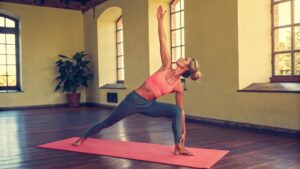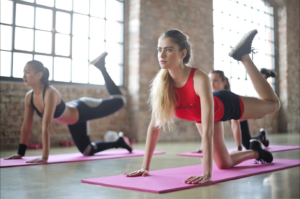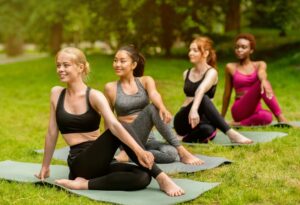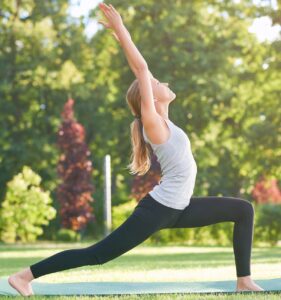Leading paragraph: Choosing a yoga mat can be confusing. The material affects grip, comfort, and eco-friendliness. Let’s break down the options so you pick the best one for your practice.
Snippet paragraph: Yoga mats come in TPE, EVA, cork, jute, or rubber. TPE and EVA are affordable and durable, while natural materials like cork offer better grip but need more care. Pick based on your budget, practice style, and eco-preferences.

Transition Paragraph: Understanding materials is just the start. Next, let’s explore why TPE and EVA mats dominate the market—and whether they’re right for you.
The Benefits of TPE/EVA Yoga Mats: Why They Are the Modern Choice?
Leading paragraph: Sleek, lightweight, and budget-friendly—TPE and EVA mats are popular for good reason. But are they the best fit for your yoga routine?
Snippet paragraph: TPE and EVA mats are lightweight, easy to clean, and provide decent cushioning. They’re ideal for beginners or frequent travelers. However, they may lack the grip of natural materials for intense practices.

Dive deeper Paragraph:
Why TPE/EVA Leads the Market
- Affordability: Priced lower than cork or rubber, these synthetic mats offer great value.
- Durability: Resistant to tears and moisture, they last longer with basic care.
- Portability: Often foldable or roll thin, perfect for yoga on the go.
| Feature | TPE Mat | EVA Mat |
|---|---|---|
| Eco-Friendliness | Moderate (recyclable) | Low (less biodegradable) |
| Cushioning | Medium | High |
| Best For | Hot yoga, travel | Home practice |
However, sweaty practices might require extra towels for grip. If sustainability is a priority, consider TPE over EVA—it’s recyclable in some regions.
The Allure and Challenges of Natural Mats: Cork, Jute, and Rubber
Leading paragraph: Natural mats promise eco-conscious grip and style. But are they practical for daily use, or just Instagram trophies?
Snippet paragraph: Cork and jute mats excel in grip and sustainability but demand regular maintenance. Rubber mats offer superior cushioning but can be heavy and pricey.

Dive deeper Paragraph:
Comparing Natural Options
Cork:
Pros: Antibacterial, improves grip with moisture (ideal for hot yoga).
Cons: Requires air-drying; may warp if rolled tightly.
Jute:
Pros: Ultra-durable and compostable.
Cons: Rough texture; not cushioned enough for knees.
Rubber:
Pros: Superior shock absorption1 for joint protection.
Cons: Heavy smell initially; avoid direct sunlight to prevent cracking.
Maintenance Tip: Clean natural mats with vinegar-water sprays—harsh chemicals degrade them faster.
Beyond Stickiness: Unpacking the Real Factors of Yoga Mat Grip
Leading paragraph: Sticky mats aren’t just about texture. Humidity, sweat, and even your stance affect traction. Let’s decode the science.
Snippet paragraph: Grip depends on material porosity2 and surface design. Open-cell mats (like TPE) absorb sweat for better traction, while textured rubber mats rely on patterns to prevent slips.

Dive deeper Paragraph:
Key Grip Influencers
- Surface Design:
- Dots/Ribs: Common in PVC/rubber mats; redirects sweat.
- Smooth: Needs moisture (e.g., cork) for adhesion.
- Your Practice:
- Vinyasa/Ashtanga: Opt for rubber or textured TPE.
- Yin/Restorative: Smooth cork works if you don’t sweat much.
- Climate: Humid areas? Avoid closed-cell mats (like basic EVA)—they get slippery.
Quick Fix: Keep a microfiber towel handy for extra slip resistance.
How Much Cushion Do Your Joints Need? A Guide to Yoga Mat Thickness
Leading paragraph: Thin mats vs. thick ones—your joints will thank you (or not) based on this choice.
Snippet paragraph: 4–6mm mats balance cushioning and stability. Choose thicker (6mm+) for joint issues or thinner (1–3mm) for travel and precise balance poses.

Dive deeper Paragraph:
Thickness Cheat Sheet
| Thickness | Best For | Limitations |
|---|---|---|
| 1–3mm | Travel, advanced yogis | Poor knee cushioning |
| 4–6mm | Most practices | Slightly heavy |
| 6mm+ | Arthritis/recovery | Harder to balance |
Note: Thicker mats might dull floor contact in standing poses. Test before buying!
The Lifespan of Your Mat: Durability Factors and Care Secrets
Leading paragraph: A fraying mat distracts your practice. Extend its life with simple habits.
Snippet paragraph: Rotate your mat monthly to even out wear. Clean synthetic mats with mild soap, natural ones with vinegar. Avoid folding—roll loosely to prevent creases.

Dive deeper Paragraph:
Care by Material
| Material | Cleaning | Storage | Avg Lifespan |
|---|---|---|---|
| TPE/EVA | Soap + water | Rolled, no sunlight | 1–2 years |
| Cork/Jute | Vinegar spray | Lay flat to dry | 3–5 years |
| Rubber | Baking soda paste | Hang to air | 5+ years |
Pro Tip: For TPE/EVA, avoid oil-based cleaners—they break down the material faster.
Conclusion
Pick a mat that fits your budget, practice style, and eco-values. Start with TPE for affordability, or invest in cork/rubber for long-term grip and comfort.
![]()


